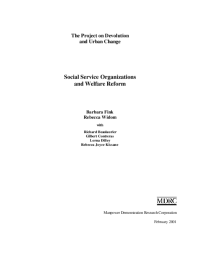Social Service Organizations and Welfare Reform
Social service organizations address a wide range of low-income families’ needs. These agencies are part of a larger system that involves government provision of services and government funding for private institutions. Significant change in one part of this network affects the others. The Personal Responsibility and Work Opportunity Reconciliation Act (PRWORA), passed in 1996, dramatically changed welfare policies. Welfare recipients now face time limits on eligibility for cash assistance, requirements that they must engage in work or work activities, and incentives and supports to encourage them to find employment. Because these welfare policy changes are so dramatic, many anticipate that the delivery of social services by private organizations will also be affected.
Predictions about the effects of welfare reform on social service agencies vary widely. Supporters of welfare reform anticipate a general increase in employment and a decrease in poverty. These predictions suggest that private donations to social service organizations will increase, allowing churches and other private agencies to play a larger role in helping families. Thus, the government safety net will be less and less needed over time. Critics, on the other hand, predict an increase in poverty and homelessness, even as social service organizations lack the resources to handle the increased needs of poor families. This is a vision of government pulling out of the social safety net without reinforcing the supportive services for people in poverty.
In order to fully understand how welfare reform influences the well-being of low-income families and communities, we must learn how human service organizations are affected by new welfare policies. This report examines agency staff members’ knowledge about welfare reform, their overall views of welfare reform, their experience of its impact on their agencies, and their expectations of how it will affect them. The findings offer preliminary insights into how new government policies shape other components of the network of service provision that is essential to the well-being of low-income families.
The Findings in Brief
- Agency staff were generally aware that major changes in welfare policy had occurred, but few expressed detailed knowledge of the policies.
- The overwhelming majority of respondents expressed negative or mixed views of welfare reform.
- Changes attributed to welfare reform began soon after the policies were implemented, but these changes have not yet been as dramatic as the critics of reform have predicted.
- Changes in the demand for education and training services have been the biggest effect of welfare reform so far. Agencies’ experiences — whether demand increased or decreased — depended partly on the state and local welfare policies and how they were implemented.
- Most basic needs organizations have not yet seen an increase in demand. Nor, however, have they seen increases in private donations as predicted by supporters of welfare reform. Moreover, the experiences of a few Cleveland agencies suggest that time limits or sanctioning policies that cause many people to lose benefits will significantly affect the demand faced by these private charities.
- Despite the limited impact that the first year of welfare reform had on community organizations, respondents anticipate that the new policies will appreciably increase the demand for their services in the future. Many, however, have no plans for meeting the new needs or the possible rise in demand.






